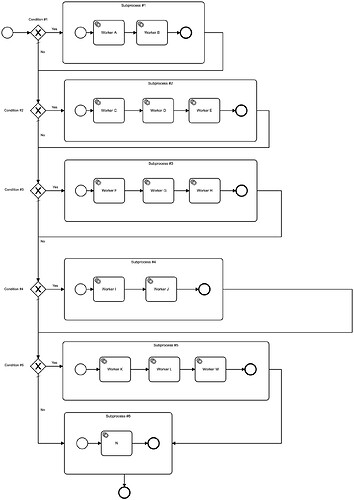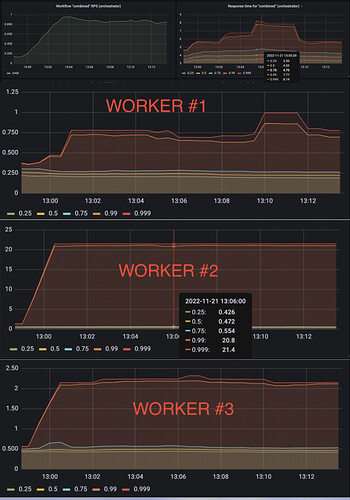Hello @Zelldon , I’ll try to answer your questions, @vasyl probably will add later regarding the workers and clients
8.0.5 zeebe version, Java 17 client for workers
Cluster deployed to k8s on bare metal ( VM’s in the local data center)
Currently we have 5 zeebe brokers and 1 standalone gateway in the cluster
We use hazelcast exporter to the external HZ cluster and simple-monitor. It doesn’t work, but it is another problem anyway
The type of disks is SSD and they should be reasonably fast.
Regarding metrics - we have metrics collected by Prometheus and showing in Grafana. Actually, there are dozens of them and I can not see any signs of slow processing. We can share any dashboards if it helps.
Broker configuration
{
"network" : {
"host" : "0.0.0.0",
"portOffset" : 0,
"maxMessageSize" : "4MB",
"advertisedHost" : "zb-zeebe-0.zb-zeebe.dev.svc.cluster.local",
"commandApi" : {
"host" : "0.0.0.0",
"port" : 26501,
"advertisedHost" : "zb-zeebe-0.zb-zeebe.dev.svc.cluster.local",
"advertisedPort" : 26501,
"address" : "0.0.0.0:26501",
"advertisedAddress" : "zb-zeebe-0.zb-zeebe.dev.svc.cluster.local:26501"
},
"internalApi" : {
"host" : "0.0.0.0",
"port" : 26502,
"advertisedHost" : "zb-zeebe-0.zb-zeebe.dev.svc.cluster.local",
"advertisedPort" : 26502,
"address" : "0.0.0.0:26502",
"advertisedAddress" : "zb-zeebe-0.zb-zeebe.dev.svc.cluster.local:26502"
},
"security" : {
"enabled" : false,
"certificateChainPath" : null,
"privateKeyPath" : null
},
"maxMessageSizeInBytes" : 4194304
},
"cluster" : {
"initialContactPoints" : [ "zb-zeebe-0.zb-zeebe.dev.svc.cluster.local:26502", "zb-zeebe-1.zb-zeebe.dev.svc.cluster.local:26502", "zb-zeebe-2.zb-zeebe.dev.svc.cluster.local:26502", "zb-zeebe-3.zb-zeebe.dev.svc.cluster.local:26502", "zb-zeebe-4.zb-zeebe.dev.svc.cluster.local:26502" ],
"partitionIds" : [ 1, 2, 3, 4, 5, 6, 7, 8, 9, 10 ],
"nodeId" : 0,
"partitionsCount" : 8,
"replicationFactor" : 2,
"clusterSize" : 5,
"clusterName" : "zb-zeebe",
"heartbeatInterval" : "PT0.25S",
"electionTimeout" : "PT2.5S",
"membership" : {
"broadcastUpdates" : false,
"broadcastDisputes" : true,
"notifySuspect" : false,
"gossipInterval" : "PT0.25S",
"gossipFanout" : 2,
"probeInterval" : "PT1S",
"probeTimeout" : "PT0.1S",
"suspectProbes" : 3,
"failureTimeout" : "PT10S",
"syncInterval" : "PT10S"
},
"raft" : {
"enablePriorityElection" : true
},
"messageCompression" : "NONE"
},
"threads" : {
"cpuThreadCount" : 8,
"ioThreadCount" : 8
},
"data" : {
"directory" : "/usr/local/zeebe/data",
"logSegmentSize" : "128MB",
"snapshotPeriod" : "PT5M",
"logIndexDensity" : 100,
"diskUsageMonitoringEnabled" : true,
"diskUsageReplicationWatermark" : 0.99,
"diskUsageCommandWatermark" : 0.97,
"diskUsageMonitoringInterval" : "PT1S",
"logSegmentSizeInBytes" : 134217728,
"freeDiskSpaceCommandWatermark" : 61399204,
"freeDiskSpaceReplicationWatermark" : 20466401
},
"exporters" : {
"hazelcast" : {
"jarPath" : "/usr/local/zeebe/exporters/zeebe-hazelcast-exporter-jar-with-dependencies.jar",
"className" : "io.zeebe.hazelcast.exporter.HazelcastExporter",
"args" : {
"clusterName" : "dev",
"name" : "zeebe-dev",
"remoteAddress" : "hz-hazelcast.test:5701",
"remoteConnectionTimeout" : "PT30S"
},
"external" : true
}
},
"gateway" : {
"network" : {
"host" : "0.0.0.0",
"port" : 26500,
"minKeepAliveInterval" : "PT30S"
},
"cluster" : {
"contactPoint" : "0.0.0.0:26502",
"requestTimeout" : "PT15S",
"clusterName" : "zeebe-cluster",
"memberId" : "gateway",
"host" : "0.0.0.0",
"port" : 26502,
"membership" : {
"broadcastUpdates" : false,
"broadcastDisputes" : true,
"notifySuspect" : false,
"gossipInterval" : "PT0.25S",
"gossipFanout" : 2,
"probeInterval" : "PT1S",
"probeTimeout" : "PT0.1S",
"suspectProbes" : 3,
"failureTimeout" : "PT10S",
"syncInterval" : "PT10S"
},
"security" : {
"enabled" : false,
"certificateChainPath" : null,
"privateKeyPath" : null
},
"messageCompression" : "NONE"
},
"threads" : {
"managementThreads" : 1
},
"security" : {
"enabled" : false,
"certificateChainPath" : null,
"privateKeyPath" : null
},
"longPolling" : {
"enabled" : true
},
"interceptors" : [ ],
"initialized" : true,
"enable" : false
},
"backpressure" : {
"enabled" : true,
"algorithm" : "VEGAS",
"aimd" : {
"requestTimeout" : "PT1S",
"initialLimit" : 100,
"minLimit" : 1,
"maxLimit" : 1000,
"backoffRatio" : 0.9
},
"fixed" : {
"limit" : 20
},
"vegas" : {
"alpha" : 3,
"beta" : 6,
"initialLimit" : 20
},
"gradient" : {
"minLimit" : 10,
"initialLimit" : 20,
"rttTolerance" : 2.0
},
"gradient2" : {
"minLimit" : 10,
"initialLimit" : 20,
"rttTolerance" : 2.0,
"longWindow" : 600
}
},
"experimental" : {
"maxAppendsPerFollower" : 2,
"maxAppendBatchSize" : "32KB",
"disableExplicitRaftFlush" : false,
"rocksdb" : {
"columnFamilyOptions" : { },
"enableStatistics" : false,
"memoryLimit" : "512MB",
"maxOpenFiles" : -1,
"maxWriteBufferNumber" : 6,
"minWriteBufferNumberToMerge" : 3,
"ioRateBytesPerSecond" : 0,
"disableWal" : true
},
"raft" : {
"requestTimeout" : "PT5S",
"maxQuorumResponseTimeout" : "PT0S",
"minStepDownFailureCount" : 3,
"preferSnapshotReplicationThreshold" : 100,
"preallocateSegmentFiles" : true
},
"partitioning" : {
"scheme" : "ROUND_ROBIN",
"fixed" : [ ]
},
"queryApi" : {
"enabled" : false
},
"consistencyChecks" : {
"enablePreconditions" : false,
"enableForeignKeyChecks" : false,
"settings" : {
"enablePreconditions" : false,
"enableForeignKeyChecks" : false
}
},
"features" : {
"enableYieldingDueDateChecker" : false
},
"maxAppendBatchSizeInBytes" : 32768
},
"executionMetricsExporterEnabled" : false
}```

